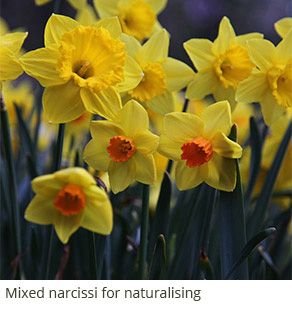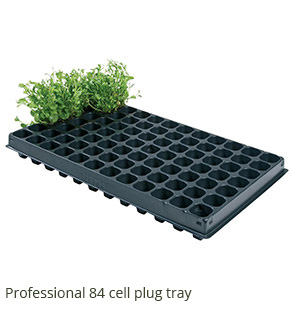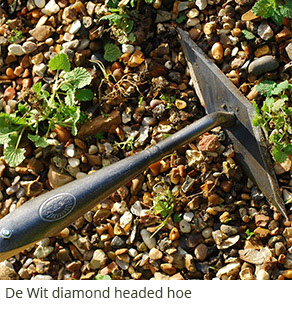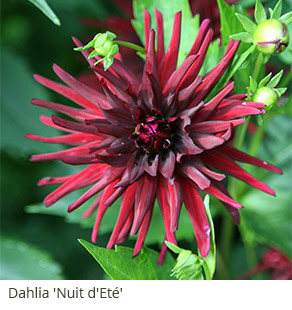March is when the gardening year starts again, especially if you’re planning to grow edible crops. A lot of gardeners invest in a few tomatoes and peppers, but although they’re delightful to eat these tender beauties only last a summer. They crop just as the supermarkets are selling off a glut rather cheaply. Edible fruit, on the other hand, is always pricey and once planted it will crop for several years running and provide you with a vitamin packed, sun warmed harvest. Create your own personal paradise and rediscover the joys of being a primitive hunter gatherer once again.
 It’s a perfect time to plant and, even those with smaller gardens, can grow some edible fruit to pick and eat in the summer months. You might use a raised bed, or containers, or you could plant a blackberry against a shed wall, or train one up a pergola. If you plan carefully, you could be picking fruit from June until late autumn, although you must keep your tempting fruit away from the beaks of marauding blackbirds. It’s a perfect time to plant and, even those with smaller gardens, can grow some edible fruit to pick and eat in the summer months. You might use a raised bed, or containers, or you could plant a blackberry against a shed wall, or train one up a pergola. If you plan carefully, you could be picking fruit from June until late autumn, although you must keep your tempting fruit away from the beaks of marauding blackbirds.
Strawberries are the obvious choice and, if you want lots of luscious summer fruit, pick a seasonal one that only crops for a short period, not an everbearer. One of my personal favourites is the early American-bred AGM variety ‘Honeoye’, because it has a sweet flavour and lots of rounded bright red fruit from June onwards. The more recent ‘Sweetheart’, bred at East Malling in Kent in 2010, is a mid-season variety with dark red conical fruit. Follow that up with ‘Fenella’, another 2010 East Malling variety, and you’ll get over two months of fruit. ‘Fenella’ produces large, glossy berries with a mildly aromatic sweet flavour.
These modern varieties are disease resistant and tend not to get mildew or verticillium wilt. The berries will also resist heavy rain. You won’t get much (if any) fruit this year, but next year you’ll get a bumper crop and your plants can stay put for five years. Then it’s best to dig them up because strawberries are virus-prone.
As you can imagine, producing all those luscious berries requires lots of food, sun and water, so if you’re growing strawberries in containers water them well in the growing season. Use sturdy wide-mouthed pots that don’t have a lip where slugs can hide. Use a loam-based John Innes compost, because this retains moisture and nutrients, and stand your pots in a saucer in summer. Begin to feed your plants with a high potash feed, such as Vitax Q4, to encourage early May flower. Frost is the great enemy at this stage, so fleece your plants on chilly nights, because otherwise the flowers will turn black and produce no fruit at all. Give them a bright position but avoid midday sun.
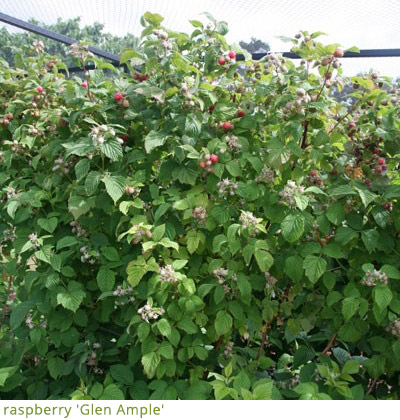 Don’t be put off ‘everbearing' strawberries because varieties like ‘Albion’ crop between May and September, producing smaller fruits with an alpine-strawberry flavour and children (of all ages) love to pick them. These are often good on garden edges close to paths. Strawberries are rich in vitamins C and K and they contain anthocyanins that are anti-inflammatory, antimicrobial and anti-carcinogenic. They also lower the risk of cardiovascular disease and many other colourful fruits have the same properties. Don’t be put off ‘everbearing' strawberries because varieties like ‘Albion’ crop between May and September, producing smaller fruits with an alpine-strawberry flavour and children (of all ages) love to pick them. These are often good on garden edges close to paths. Strawberries are rich in vitamins C and K and they contain anthocyanins that are anti-inflammatory, antimicrobial and anti-carcinogenic. They also lower the risk of cardiovascular disease and many other colourful fruits have the same properties.
The obvious follow up act is a summer raspberry, although these are best grown in the ground. The Scottish-bred ‘Glen Ample’ produces large, conical-shaped berries with an excellent flavour usually for three or four weeks in July. This will need support to grow on and some pruning in the autumn when the old canes are cut out to pave the way for the new ones - which will then go on to produce the following years crop. These remaining canes can be tipped (remove the top few inches) in late winter to encourage them to bush out.
If space is tight in your garden, you’re better to go for an autumn-fruiting raspberry because these produce an abundance of berries over three months. ’Autumn Bliss’ is still the gardener’s favourite and I’m often picking some right up until late October in my own garden. They freeze well too and they need little maintenance and no supports. Cut them back in late winter, to a few inches. 'Tadmor' will bridge the gap between summer and autumn crops because it fruits between mid-July and late summer.
Adding a blackberry is also an excellent idea, because they can be trained on a sunny side of a fence or shed where they take up little room. They will need supports and you will need to cut away the old canes and tie in the new ones in autumn because most fruit on next year’s wood. In recent years lots of new American plant breeding has produced a primocane variety called ‘Reuben’, bred in Arkansas. It’s very hardy but likes a lot of summer warmth. If your garden’s warm (and mine isn’t) this is an excellent option. Cut back all the growth in early spring. Another Arkansas variety, ‘Apache’, has longer fruits in August and it’s thornless. These are best eaten from the bush, on muesli for instance, because they’re sweet and juicy and don’t need cooking.
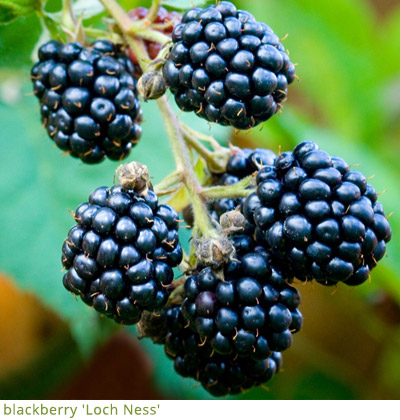 The Scottish-bred ‘Loch Ness’, which fruits on next year’s growth, does well in my garden, spanning the south-facing side of the garden shed. It’s August fruiting and we get about 4kg of large round fruits. It takes up little room and the white blossom is very bee and butterfly friendly. You can eat ‘Loch Ness’ raw, or lightly cook it - or it will freeze well. Blackberry bushes take a little time to establish and you need to find them a position that is well-drained. They hate winter wet. The Scottish-bred ‘Loch Ness’, which fruits on next year’s growth, does well in my garden, spanning the south-facing side of the garden shed. It’s August fruiting and we get about 4kg of large round fruits. It takes up little room and the white blossom is very bee and butterfly friendly. You can eat ‘Loch Ness’ raw, or lightly cook it - or it will freeze well. Blackberry bushes take a little time to establish and you need to find them a position that is well-drained. They hate winter wet.
Blackcurrants are very easy to grow and tolerant of most conditions. The commercial crop, grown for that famous blackcurrant drink, is grown in Herefordshire and they get plenty of rain. If you’re very dry opt for a redcurrant instead. However blackcurrants are more versatile because they cook well, freeze well and you can even make your own cordial. The ‘Ben’ varieties are all bred in Scotland and they have some frost resistance because blackcurrants tend to flower early. ‘Ben Conan’ is an AGM variety that produces large fruit from mid-July onwards. ‘Big Ben’, another AGM winner, produces bumper crops and it’s quite possible to get nearly 10 kilos of fruit from one bush. These do best in the ground under fruit netting.
Other delights come in all shapes and sizes and if you’ve got a sunny position and lots of room you could grow a ‘Brown Turkey’ fig in a huge pot (or in the ground). These architectural plants are from the Mediterranean region so they prefer a warm, wet winter followed by a sunny summer. A sheltered niche, against a wall, is ideal. Nothing tastes better than home-grown figs and ‘Brown Turkey’ is the best one for the British climate. Do be prepared to have good years and bad years for summer sun is the magic ingredient!
 If you want to fill the gap between summer-fruit and autumn fruit, blueberries crop in late July and right through August. They’re acid-loving plants that evolved in Canada, so hardiness is not a problem. However, if you haven’t got acid soil you will need to pot them up and grow them in ericaceous compost. They’re lightly pruned in winter and you will need more than one, because these need to be outcrossed by pollinators - usually small bumble bees - if you want a bumper crop. ‘Spartan’ is an early AGM variety that crops well in my own garden. The berries are large and tangy, but do remember that blueberries aren’t heavy croppers. You get some health-boosting berries every few days. ‘Chandler’ is a mid- to late variety with huge berries the size of small grapes. If you add ‘Bluecrop’, a heavy cropping mid-season variety, you are sure to have berries for five weeks. The Blueberry Collection contains all three. If you want to fill the gap between summer-fruit and autumn fruit, blueberries crop in late July and right through August. They’re acid-loving plants that evolved in Canada, so hardiness is not a problem. However, if you haven’t got acid soil you will need to pot them up and grow them in ericaceous compost. They’re lightly pruned in winter and you will need more than one, because these need to be outcrossed by pollinators - usually small bumble bees - if you want a bumper crop. ‘Spartan’ is an early AGM variety that crops well in my own garden. The berries are large and tangy, but do remember that blueberries aren’t heavy croppers. You get some health-boosting berries every few days. ‘Chandler’ is a mid- to late variety with huge berries the size of small grapes. If you add ‘Bluecrop’, a heavy cropping mid-season variety, you are sure to have berries for five weeks. The Blueberry Collection contains all three.
It’s also a great time to plant a fruit tree and modern cherries are grafted on to modern rootstocks and they produce fruit on young trees. They are modestly sized, reaching between 3 and 4 metres on average. ’Stella’, the most popular variety grown in Britain, would be my choice because it’s a good doer. It’s also self-fertile, so fruits on its own, and the large dark red or black fruit is sweet and juicy. Expect a July crop. If you want a slightly smaller tree go for another Canadian variety called ‘Sweetheart’, another self-fertile dark-skinned sweet cherry that doesn’t need pollen from another variety, or visits from insects. However you always get a heavier crop with a pollinator. This is a late-cropping variety and the fruits ripen over a few weeks. This avoids having a glut and you can be picking well into September.
Finally, if you have a sheltered garden plums can be very productive too, but their early March blossom is susceptible to late frosts so you must find the most frost-free position you can, or be prepared to fleece. ‘Victoria’ is very prolific and reliable, with large egg-shaped fruits in August. This dual-purpose plum can be eaten raw or you can cook it. This old variety, raised in Sussex in 1840, is also self-fertile. ‘Opal’ is an earlier, dessert variety with smaller fruit that’s similar in colour to ‘Victoria’. This Swedish variety crops in late-July and it makes wonderful jam.
|








